*please check our "Agenda" for your date.
Our cruises have been scheduled during the best possible season of the year. The sea is generally very calm but larger ocean swells can be present during the crossings.
Dives normally conducted on reef edges, around coral atolls, some sand based diving and some drop offs. Exploration diving in certain areas.
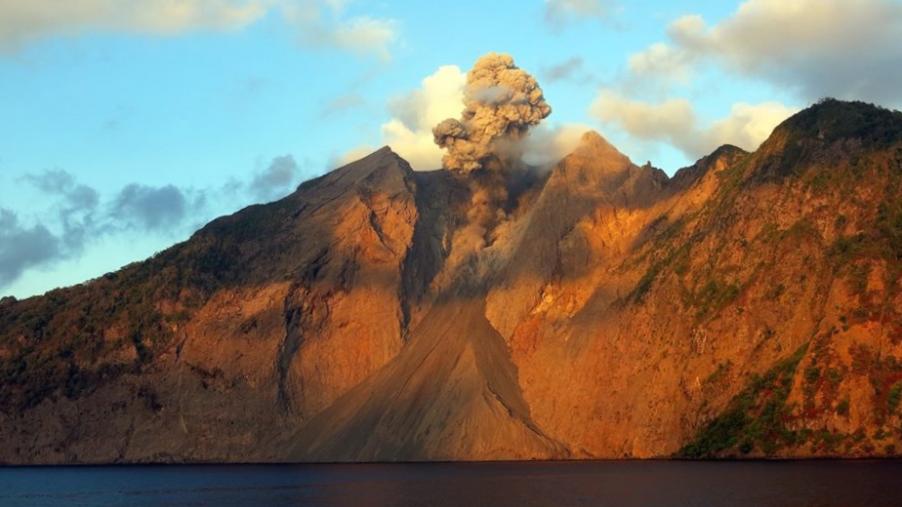
The WAOW team welcomes you at Saumlaki airport until 1:00pm (or 3:00pm in Maumere) to accompany you on board SMY WAOW (15-20mn drive). Our experienced staff will look after your luggage and transfer it to your cabin onboard SMY WAOW while you enjoy our "refreshing welcome drink". As soon as the last guests are onboard around 2:00pm (Saumlaki) or 4:00pm (Maumere), you will be introduced to our team and have plenty of time to settle in, get everything ready and enjoy life onboard with us.
Early breakfast befor disembarkation & transfer to the airport or hotel between 06.00am and 11.00am at the latest
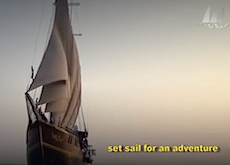
The Banda Sea is the deepest of the numerous seas that make up the beautiful Indonesian archipelago. Typically, with depths over 4,500m, and the deepest point being over 7,300m, it is a very large body of water stretching for over 1,000 km East to West, and 500 km North to South. The Banda Sea is located North of Flores and South of Seram. While there are island chains on the edges of the Banda Sea, it retains a very “oceanic” feel to it with vast stretches of deep blue water. Within the mid-section of the Banda Sea there are very few mostly tiny islets sticking out of the water from the vast depths, with the next outcrop many miles away. MSY WAOW takes you to those remote places: spots that rise from the abyss to the surface, and therefore provide a haven for marine life to concentrate around. The topography of the sites is a divers dream: to one side slopes or walls covered in a myriad of hard and soft corals, huge barrel sponges and other benthic life forms surrounded by clouds of reef fish - to the other side the deep blue of the Banda Sea – a depth from which spectacular pelagic sea creatures are likely to rise from below. One of the main objectives of this voyage are encounters with those big fish: schools of tunas and jacks, barracudas, Spanish mackerels, but also different shark species – grey reef, silky, silvertip, thresher, and the occasional tiger shark has been spotted by our guests on the dive sites of this itinerary. But the real stars of the show are the hammerhead sharks – on quite a few different locations off the atolls and islands we have found preferred places for schooling hammerheads.
The "Forgotten Islands" definitely don’t carry their name by chance. A 1’000 km chain of Islands reaching from Timor to their West and Papua New Guinea to their North East, they are separated from population centers, definitely forgotten, and off the beaten track. Luxurious vegetation originates from the combination of volcanic beginnings (Wetar, Roma, Damar, Nila) and also coral reef limestone plates surrounded by mangroves. These isolated islands are culturally Austronesian and are linked by similar populations, languages and religious traditions. Myths and beliefs can be seen and linked via the wood sculptures representing strong ancestral figures.The dive sites around the islands are among some of the most beautiful sites of all Indonesia. Waters are clear, reefs are of great variety and beauty, and drop offs are spectacular. Amongst other discoveries divers can also come across the rare weedy scorpion fish, hump head parrot fish, schools of jacks and barracuda , giant Spanish mackerel, hammerhead sharks, whale sharks or manta rays. We can also, in certain known areas, observe salt water crocodiles, from a dive tender and from a distance
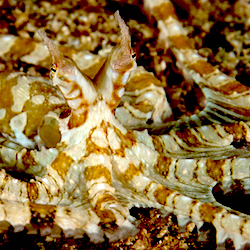
Maumere is a beautiful bay on the north coast of Flores. There is a wealth of macro life to keep any diver fascinated for hours. It’s this diversity that has also made Maumere a perfect place to finish our cruise
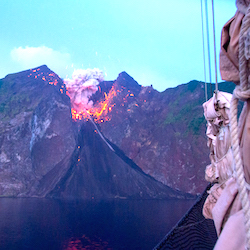
Komba is an active volcano in the Flores Sea with the smell of sulphur in the air when you are nearby. You'll find sheer walls and ridges all around the island with black volcanic sandy slopes up in the shallows. Colorful walls with soft coral, sea fans and encrusting sponges, lots of reef fish along the walls and out in the blue there's a good chance for bigger stuff like dogtooth tunas, mackerels, jacks, rays, turtles and reef sharks. Another highlight of Komba are the regular eruptions, which which turn the night sky into a spectacular natural firework display that can be witnessed from a safe distance.
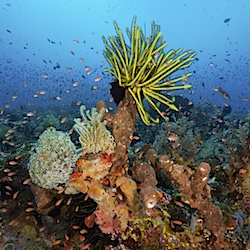
The 3 inactive volcano islands in the Strait between Alor and Pantar make it a perfect combination for some world class diving, with vertical sheer walls, numerous small coves, a good mix of fresh water, slightly sloping silky sand with swift currents that bring so many nutrients in to the bay and provide shelter for critters that take habitat here. From colourful coral to rare pelagic and critters on the seabed, the bay of Alor has it all.
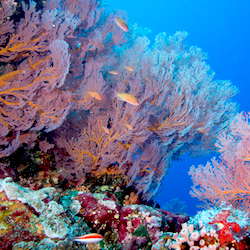
The coast of Pulau Wetar features excellent drop offs, colourful reefs and abundant fish life that swim amongst sea fans, barrel sponges and encrusting soft corals. Because of the deep waters of the Banda Sea the visibility is great and there are good chances for pelagics on the wall.
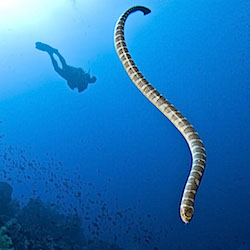
Gunung Api is a volcano that last erupted in 1988 and subsequently covered the reef in lava, however the reef has recovered faster than anyone expected. This Volcano sits alone in the middle of the Banda Sea and is home to an amazing variety of birds including shearwaters, terns, boobies, frigates and red-tailed tropic birds to mention a few, but also to sea snakes. For some reason this island in the middle of nowhere is home to hundreds if not thousands of sea snakes, banded & olive sea snakes. They are curious and swim right for you and it seems like every time you look down there is a snake poking around your fin tips! They also wind around to look at their reflection in your camera dome port and are posing for you. They are treating you as part of their environment and have no malicious intent at all.
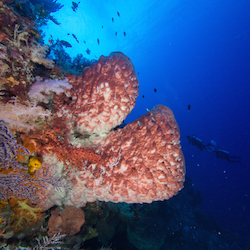
Picturesque islands with dives off white sandy beaches. Ridges teeming with fish, spectacular drop-offs and rich slopes with huge barrel sponges or dive sites characterized by swim-throughs and big overhangs, all in calm clear water offer varied easy diving.
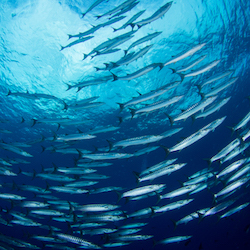
Dense schools of fish and good chances to encounter pelagics like hammerhead sharks make the diving around this group of islands just East of Timor Leste so spectacular. Diving can be either cruising along the walls of atolls, or on the current split points of ridges that lead out from corners of islands or drifting though channels in between the isles. Big variety of fish like napoleon wrasses, black and white tip reef sharks, bumphead parrot fish, immense schools of batfish, sailfin and bumphead snappers and eagle rays just to name a few.
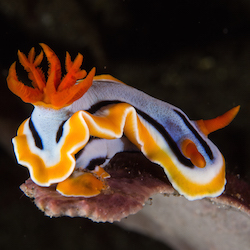
Small islands inhabited by friendly villagers and surrounded by deep, blue, clear warm water are the backdrop of this region’s sublime Banda Sea diving. Not far off the coast the nice shallows drop down into the deep blue. One is torn between exploring the spectacular walls covered in rich and diverse hard and soft corals and gazing into the blue looking for pelagics. Other sites include submerged seamounts attracting all sorts of predatory fish. While some dives are almost current free others can be challenging but at the same time spectacular as the current attracts schools of fish like rainbow runners or fusiliers. Apart from stationary big schools of barracuda and jacks, napoleon wrasses, bumphead parrotfish and fully grown groupers, pelagic species of sharks like hammerheads or silky sharks have been spotted here on several occasions.
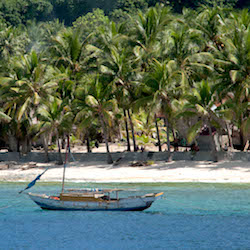
The walls of the region’s atolls provide another chance to encounter bigger sharks species like silvertips or hammerheads, as well as unique observations. How often do you literally see schooling napoleon wrasses? If luck happens to be on our side, it is possible here…While there is also a chance to encounter big stuff in the blue, the real highlight of the dives around the islands of this area are the walls themselves; not only are they covered in varied and often unique species of corals, but they are also topographically beautiful with crevices, swim-throughs and overhangs, the latter of which provide ideal habitat for more cryptic animals like frogfish, leaf scorpion fish, and several species of pygmy seahorses (pontohi, severns and even the elusive satomi have been spotted here).
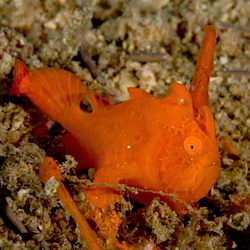
While there are a few islands surrounded by nice colorful reefs, the real highlight of this group of islands is the macro life found on shallow sand substrate. Unlike many other muck dive areas the macro dives here actually lack the ‘muck’, i.e. the human litter, and could therefore be classified as ‘clean' muck dives. What they have in common with classic muck dives though are the critters: mimic octopus, wonderpus, different species of frogfish, bob tail squids, tozuma shrimps, ghost pipe fish and toad fish have all been sighted amongst many more macro treasures.
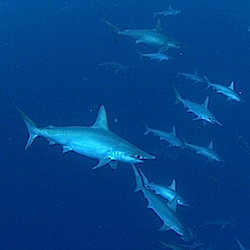
A treasure closely guarded and lost in the middle of the Banda Sea, this isolated reef runs for several kilometers and is an oasis for pelagic life. Schools of jacks patrol the edges of the reef and are joined by large numbers of hammerhead sharks on a regular basis. The coral is in good health and lovers of the macro fauna won’t be disappointed, however it is more often than not that our heads are facing into the deep blue for a special spectacle.
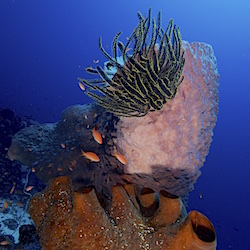
The volcanic islands and submerged reefs in the middle of the Banda Sea are calling out for exploration. Drop offs, drift dives, great visibility and the possibility of “pelagic action”.
Hello
Hello
Hello
Hello